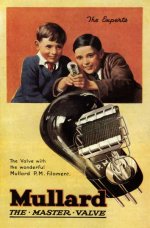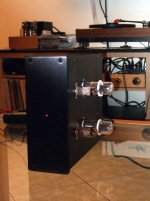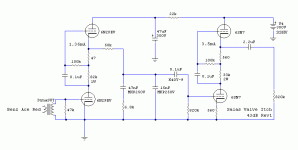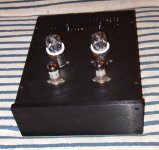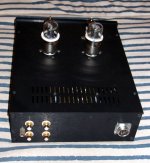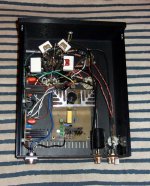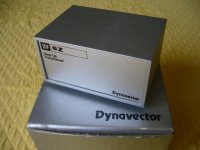Hmmm - thanks for posting this up Salas, very very interesting!!
Particularly as I have two spare 6N2P-EV tubes and some spare 6N1P-EV tubes that would go instead of the 6SN7 I think. I.e. I could actually build this without ordering too much new stuff
Oh - and I've also two spare Partridge 6:1 977 transformers
Just need to find a couple of nice boxes now, and some time!
Particularly as I have two spare 6N2P-EV tubes and some spare 6N1P-EV tubes that would go instead of the 6SN7 I think. I.e. I could actually build this without ordering too much new stuff
Oh - and I've also two spare Partridge 6:1 977 transformers
Just need to find a couple of nice boxes now, and some time!
6N1P or 6922/88/6DJ8 look like good candidates for the second stage. If my Spice models are anywhere good you should expect circa 48dB gain sans input trafo and maybe less THD. You could play with its bias point. I would grid stop it also due to its high gm. Don't know if you got to fine tune the HF Riaa cap after different TxIn and alternative 2nd stage valve though. 34n-35.2n play should suffice subjectively.
Hmmm - thanks for posting this up Salas, very very interesting!!
Particularly as I have two spare 6N2P-EV tubes and some spare 6N1P-EV tubes that would go instead of the 6SN7 I think. I.e. I could actually build this without ordering too much new stuff
Oh - and I've also two spare Partridge 6:1 977 transformers
Just need to find a couple of nice boxes now, and some time!
I'm using a pair of 977 with my Zu/Denon DL-103 and have yet to hear anything that betters it amongst the half dozen or so SUTs I had at my disposal.
I felt too deeply buried in sand. Got an itch. The valve itch.Had to mess with glass again.
I want the most gain there is available on first stage, I don't want extra resistors there, want good PSRR, and low gain at second stage.
Hi Salas.
I still haven't decided on which new phono stage to build next.
But I guess since I am mailing you from here you can see where it might be heading !
I was wondering how good you feel the PSRR on the 'itch' is.
Have been feeling quite nostalgic since dusting off the old MA-12's.
I am considering the possibility of making a 'zero silicon' version of the 'itch'.
Whilst it would no doubt contain loads of teflon, polypropylene & gold, a nice EZ81 or GZ34 or two running up the electricity bill seems quite appealing some how.
I am thinking I could use a pair of back to back 'R-cores' with extreme AC mains filtering.
Taking the supply for the rectifier/s heater/s from one of the first R-core's secondarys.
The heater supplies for the preamp tubes coming from the first R-cores second secondary, which would also be the input to the second 'backwards' R-core for the HT.
The GZ34 has a direct heater and supplies 750mA; the EZ81 an indirect heater and supplies 150mA.
It's interesting that Heathkit replaced the Mullard spec'd EZ81 with a GZ34 in their version of the 5-10. Even though the Mullard design indicates HT to outboard preamp & tuner, as does the Heathkit.
I believe some people say the GZ34 'sounds good'.
I am limited to 50uF, 60uF for the first capacitor respectivly.
But after that I could bung in a bigish choke and more caps, and more near the preamp tubes HT & filaments as well.
Also some series resistors perhaps.
I was wondering if you thought the 'itch' would find this OK ?
You may have tried the 'itch' with a similar PSU, before shunting it ?
I'd like to have a go at how they would have done it back in the 50's.
Bit of a coincidence the Mullard 5-10 design appearing in 1954.
That was the same year my dad started with the RAF in communications.
I bet they were all talking about the 'latest tech' in the NAFFE.
Here's a picture of my dad checking out the latest valve's circa 1949, a few years before.
He looked a spitting image of the kid on the right at the time !
Cheers... Simon...
Attachments
The PSRR is good enough in a Mu follower, but have no doubt, the Simplistic HV shunt reg will have a strongly audible benefit over any passive DC filtering scheme no matter how elaborate. The moment you will eliminate detectable PSU ripple in a passive for this phono, its impedance is so high VS the mOhm league of the shunt reg, its no contest.
Some Details
It has a Dynavector DV6Z step up taken out of its original box and put inside as the silver cylinder in the pictures. Also a Simpler Simplistic HV and two filament regs in the same box. Another box houses the transformers and the rectification/filtering. Feeds DC lines to the regs through a cable to that multi-pin connector which can be seen in the back panel and underside pics. The PSU is like in post #3. Changes are my HV shunt reg instead of the Maida, and equal value resistors in the heater lift network since the upper cathodes sit higher in this revision. Either the tube model's Rp/Miller played a role or the SUT shapes response, but we took out the extra 1nF Silver Mica across the *15nF nominal MKP Arcotronics Riaa caps after we measured its filtering curve with pink noise. Listening before & after confirmed. It hits 0.08% with 2mV input without the SUT, second harmonic only. 0.1% with 0.5mV and SUT. We just swapped the output Melz 6H8s between channels and a couple of 6N2PEVs for the lower tier input valve and got 0.33dB channel gain agreement. Noise floor in both cases starts at -80dB at 20Hz and falls to -120dB at 20kHz following a Riaa like attenuation shape. That is for 0dB=1VRMS calibrated. Sounds really quiet for a valve phono. Plus you can hammer it and get zero microphonics. Actually Michael had it fallen from 1.5m height to concrete floor while playing and did not make a sound other than music. Subjectively he is head over hills with it. I find it very nice too. Its better than the first easily. Will listen to more records with it in an audition only mates gathering soon.
*15nF nominal 5-10% caps can be 15n++. 15.3nF measured value with a tight & calibrated desktop meter should be ballpark.
It has a Dynavector DV6Z step up taken out of its original box and put inside as the silver cylinder in the pictures. Also a Simpler Simplistic HV and two filament regs in the same box. Another box houses the transformers and the rectification/filtering. Feeds DC lines to the regs through a cable to that multi-pin connector which can be seen in the back panel and underside pics. The PSU is like in post #3. Changes are my HV shunt reg instead of the Maida, and equal value resistors in the heater lift network since the upper cathodes sit higher in this revision. Either the tube model's Rp/Miller played a role or the SUT shapes response, but we took out the extra 1nF Silver Mica across the *15nF nominal MKP Arcotronics Riaa caps after we measured its filtering curve with pink noise. Listening before & after confirmed. It hits 0.08% with 2mV input without the SUT, second harmonic only. 0.1% with 0.5mV and SUT. We just swapped the output Melz 6H8s between channels and a couple of 6N2PEVs for the lower tier input valve and got 0.33dB channel gain agreement. Noise floor in both cases starts at -80dB at 20Hz and falls to -120dB at 20kHz following a Riaa like attenuation shape. That is for 0dB=1VRMS calibrated. Sounds really quiet for a valve phono. Plus you can hammer it and get zero microphonics. Actually Michael had it fallen from 1.5m height to concrete floor while playing and did not make a sound other than music. Subjectively he is head over hills with it. I find it very nice too. Its better than the first easily. Will listen to more records with it in an audition only mates gathering soon.

*15nF nominal 5-10% caps can be 15n++. 15.3nF measured value with a tight & calibrated desktop meter should be ballpark.
Attachments
Still more temptations!!!!!
+1
Just finished V1.2R, so please Nick stop to do a lot of very good projects I don't have time to follows you
- Home
- Source & Line
- Analogue Source
- Valve Itch phono
